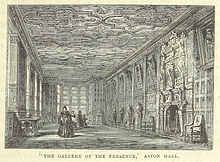Aston Hall
| Aston Hall | |
|---|---|
 | |
 | |
| General information | |
| Type | Mansion |
| Architectural style | Jacobean |
| Location | Aston, Birmingham, England |
| Coordinates | 52°30′23″N 1°53′3″W / 52.50639°N 1.88417°W |
| Construction started | April 1618 |
| Completed | April 1635 |
| Design and construction | |
| Architect(s) | John Thorpe |
| Awards and prizes | Grade I listed |
Aston Hall is a Grade I listed Jacobean house in Aston, Birmingham, England, designed by John Thorpe and built between 1618 and 1635. It is a leading example of the Jacobean prodigy house.
In 1864 the house was bought by Birmingham Corporation, becoming the first historic country house to pass into municipal ownership, and is still owned by Birmingham City Council. It is now a community museum managed by the Birmingham Museums Trust and is open to the public during the summer months, after a major renovation completed in 2009.
History
Designed by John Thorpe, construction commenced in April 1618 by Sir Thomas Holte, who finally moved into the hall in 1631. It was completed in April 1635. It is Grade I listed.[1]

The house was severely damaged after an attack by Parliamentary troops in 1643; some of the damage is still evident. There is a hole in the staircase where a cannonball went through a window, an open door and into the banister. The house was built by Sir Thomas Holte and remained in the family until 1817 when it was sold and leased by James Watt Jr., son of industrial pioneer James Watt. The house was then purchased in 1858 by a private company (the Aston Hall and Park Company Ltd) for use as a public park and museum. After financial difficulties it was then bought by the Birmingham Corporation in 1864 becoming the first historic country house to pass into municipal ownership.
It was also visited by Washington Irving, who wrote about it as Bracebridge Hall, taking the name from Abraham Bracebridge, husband of the last member of the Holte family to live there. Irving's The Sketch Book stories depicted harmonious warm-hearted English Christmas festivities he experienced while staying in Aston Hall, that had largely been abandoned.[2] An Aston Hall Christmas Eve custom the owners afforded the servants of the house appeared in The Gentleman's Magazine in 1795, which wrote, "the servants have full liberty to drink, dance, sing, and go to bed when they please."[3]
For a few years from 1878 the collections of art and the Museum of Arms were moved to Aston Hall after a fire damaged the municipal Public Library and Birmingham and Midland Institute which shared a building in Paradise Street, until the building of the current Art Gallery in the Council House.

In the 1920s, the Birmingham Corporation was having financial troubles and had to choose between saving Aston Hall and the nearby Perry Hall. Aston Hall was saved and in 1927, The Birmingham Civic Society designed formal gardens which were implemented by the city with a workforce recruited from the unemployed and paid for by government grants. However, the scheme included fountains, terracing and stone urns and a statue of Pan, by William Bloye, which the Civic Society paid for itself. In 1934 the finished work was presented to the City Parks Committee and unveiled by the Vice President of The Birmingham Civic Society, Sir Gilbert Barling, Bart, CB, CBE. As of January 2011, Birmingham City Council are working on the restoration of the statue, whose head is missing. They have appealed for old photographs, to assist in its reconstruction.[4]
Current status
Aston Hall is now a community museum managed by Birmingham Museums Trust, having previously been managed by Birmingham City Council until 2012. Aston Hall is open to the public during the summer months, following extensive renovation from 2006-2009. It boasts a series of period rooms which have furniture, paintings, textiles and metalwork from the collections of the Birmingham Museum & Art Gallery. Visible from the House less than 200 yards to the north is Aston Villa Football club stadium.
The easternmost part of the grounds made way for the A38(M) motorway, also known as the Aston Expressway. This opened in 1972 and gave the city centre a direct link with the M6 motorway.
In fiction
Washington Irving used Aston Hall as the model for Bracebridge Hall in his The Sketch Book of Geoffrey Crayon, Gent..
References
- ^ Historic England. "Details from listed building database ({{{num}}})". National Heritage List for England. Retrieved 17 September 2009.
- ^ Kelly, Richard Michael (ed.) (2003), A Christmas Carol. p.20. Broadview Literary Texts, New York: Broadview Press, ISBN 1-55111-476-3
- ^ Dawson, William Francis (2007). The Project Gutenberg eBook, Christmas: Its Origin and Associations Project Gutenburg
- ^ "The mystery of the headless statue". Birmingham Newsroom. Birmingham City Council. 17 January 2011. Retrieved 17 January 2011.
- Davies, Stuart. By the Gains of Industry - Birmingham Museums and Art Gallery 1885-1985. Birmingham Museums and Art Gallery. ISBN 0-7093-0131-6.
- Haywood, William (1946). The Work of The Birmingham Civic Society 1918-46. Kynoch Press.
- Hickman, Douglas (1970). Birmingham. Studio Vista Limited.
- Collection of Prints: With Brief Descriptive Notes, Anastatic Drawing Society, 1858
External links
- Aston Hall- Official website
- Aston Hall - Service for schools - Educational teaching sessions and resources at Aston Hall
- Aston Hall for Kids - fun and games for children based on Aston Hall
- Houses in Birmingham, West Midlands
- Museums in Birmingham, West Midlands
- Parks and open spaces in Birmingham, West Midlands
- Historic house museums in the West Midlands (county)
- Grade I listed buildings in Birmingham
- Grade I listed houses
- Conservation areas in England
- Houses completed in 1635
- 1635 establishments in England
